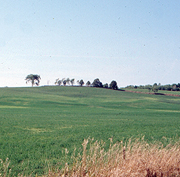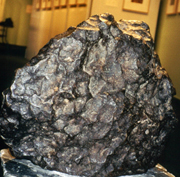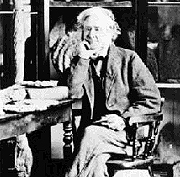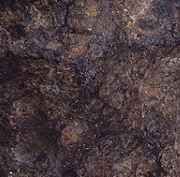Official Name:
Madoc is the name of the village near where this meteorite was discovered.
Location:
West of Madoc, Hastings County, Ontario, Canada.
Fall or Find:
Madoc is a find-the meteoroid's fall was not observed. The meteorite spent a fairly long time on the ground, because it is covered with a fine film of oxidation. In addition, the first few centimetres below its surface have been altered by Earth's climate.
Date:
Madoc was found in the autumn of 1854.
Mass Recovered:
This meteorite weighs 167.8 kilograms. It is the second largest meteorite found in Canada.

Enlargement
The Madoc meteorite bears the name of the Ontario farming village where it was found in 1854. |
|

Enlargement
The Madoc meteorite is displayed on a marble stand. Madoc is rectangular and flattened, with an irregular surface. |
|
Number of Fragments:
A single metallic mass was recovered.
Circumstances:
Little information is available concerning the recovery of this meteorite. When it was discovered, the meteorite was lying on the ground. We do not know whether or not it was lying in a crater-nor do we know the name of the person who found it.
History:
Madoc was the first piece in the National Meteorite Collection of Canada. William Logan and Thomas Sterry Hunt of the Geological Survey of Canada acquired the precious mass of iron in 1855. That same year, the Madoc meteorite crossed the Atlantic to be shown at the Universal Exposition in Paris, France. More recently, the meteorite has been exhibited at the Planétarium de Montréal (1995), the Montreal Museum of Fine Arts (1999), and the Canadian Museum of Nature (2002).

Enlargement
Sir William Logan, founder of the Geological Survey of Canada. He negotiated the purchase of the Madoc meteorite one year after it was discovered. |
|

Enlargement
In-depth chemical analyses demonstrated that the Manitouwabing meteorite is not related to the Madoc meteorite. |
|
Type:
Iron meteorite
Class:
Medium octahedrite. The bands have an average width of a little under one millimetre (0.95 mm).
Group:
IIIAB
Composition:
The Madoc octahedrite contains very little nickel-this metal only accounts for 7.5% of its volume. Plessite, an alloy, is relatively abundant in the meteorite. This is why one of the first scientists to study Madoc's composition gave the meteorite its own class: madocite. Later analyses showed that the presence of plessite did not justify creating a new class of meteorites.
Scientific contribution:
It was suggested that the meteorites Madoc and Manitouwabing (a find made in the same county) may have come from the same fall. This hypothesis was made after comparing their germanium, gallium, and iridium contents. Further research showed the two meteorites to be distinct. Their concentrations of platinum and ruthenium differed too greatly. In light of these results, scientists established that platinum and ruthenium content should be used when comparing iron meteorites.
Comments:
A few fragments of the meteorite have been distributed to scientific institutions and museums throughout the world. The main mass is on display in Logan Hall at the Geological Survey of Canada office in Ottawa. It weighs 156 kilograms today-which means that a little over 10 kilograms have been cut off of it.
Part of the Planétarium's collection:
No